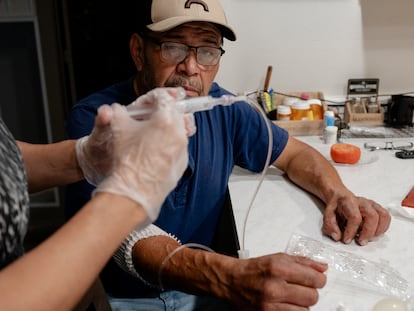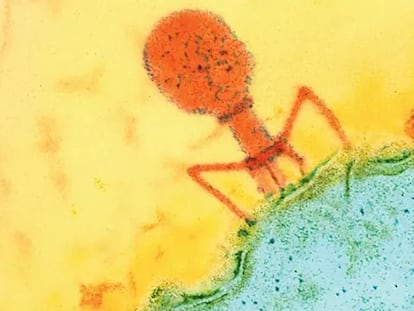Antibiotic resistance threatens to kill 208 million people in 25 years
A study published in ‘The Lancet’ warns that deaths from diseases that do not respond to antimicrobials will increase dramatically among the over-70 population

Infections, surgeries and ordinary medical practices have become life-or-death situations for many people, just as they were before 1928, when penicillin was discovered and antibiotics were born. Antibiotics have saved the lives of millions of people, who — if not for treatment — would have died from simple bacterial pneumonia (in the 1930s it killed almost 40% of patients) or from the after-effects of a common infection.
But over the years, bacteria have learned to resist the effects of antibiotics. So much so that antibiotic resistance is one of the top 10 threats to humanity, according to the World Health Organization (WHO). A projection published by The Lancet on Tuesday estimates that antimicrobial resistance (AMR) could directly kill more than 39 million people and indirectly kill 169 million (due to problems associated with other pathologies) in 25 years — a total of 208 million people. According to the study — which analyzed 520 million individual records from 1990 to 2021 — AMR will hit the over-70 demographic particularly hard, with deaths rising by 72% in high-income countries and 234% in North Africa and the Middle East.
“We are reaching the post-antibiotic era, when we will no longer have resources that work,” says Luis Ostrosky, head of infectious diseases and epidemiology at UTHealth Houston, who was not involved in the study. “Medicine depends on the use of antibiotics for things as routine as surgeries, therapies or transplants, and we are in a very dangerous time in history because antimicrobial resistance is increasing. In daily medical practice, we are finding infections that are not treatable with the antibiotics that exist now, and that is very serious.”
The deadly effects of the post-antibiotic era began to be recorded 30 years ago. Between then and 2020, more than one million people (between 1.06 and 1.14 million) have died annually due to antimicrobial resistance, with adults 70 years and older experiencing a more than 80% increase in AMR mortality, according to the new study by the Global Research Project on Antimicrobial Resistance (GRAM).
If this trend continues, the study projects that the annual number of AMR deaths will rise to 1.91 million by 2050 — nearly double the current figure. If AMR-associated deaths are also included, the number of fatalities is projected to rise to between 4.71 million and 8.22 million per year — an increase of almost 75%.
On the rise
“These findings highlight that AMR has been a significant global health threat for decades and that this threat is growing,” said study author, Dr Mohsen Naghavi, from the Institute for Health Metrics (IHME) at the University of Washington. “Understanding how trends in AMR deaths have changed over time, and how they are likely to shift in the future, is vital to make informed decisions to help save lives.”
The study reflects a mixed trend: while it warns that the over-70 population is projected to see a rise in AMR deaths, children under five are expected to see a fall. According to the research, AMR deaths will drop from 488,000 to 193,000, while AMR-associated deaths will fall from 2.29 million to 840,000. This positive trend is due to improvements in infection prevention and control measures.
“The decline in deaths from sepsis [an extreme immune system response to an infection that damages tissues and organs] and AMR among young children over the past three decades is an incredible achievement,” said Kevin Ikuta, Ph.D., from the University of California, Los Angeles (UCLA), and co-author of the study. “However, these findings show that while infections have become less common in young children, they have become harder to treat when they occur. Further, the threat to older people from AMR will only increase as populations age. Now is the time to act to protect people around the world from the threat posed by AMR.”
“To prevent this from becoming a deadly reality, we urgently need new strategies to decrease the risk of severe infections through vaccines, new drugs, improved healthcare, better access to existing antibiotics, and guidance on how to use them most effectively,” added study author Dr Stein Emil Vollset of the Norwegian Institute of Public Health and affiliate professor at IHME.
According to the research, improving infection care and access to antibiotics could prevent 92 million deaths. The importance of preventive measures is supported by the fact that the sustained upward trend in AMR temporarily decreased in 2021 due to social distancing and other disease control measures implemented during the Covid-19 pandemic.
But the biggest game changer would be the discovery of new antibiotics as, “antimicrobial medicines are one of the cornerstones of modern healthcare, and increasing resistance to them is a major cause for concern,” said Naghavi.
New antibiotics
For years, César de la Fuente, from the University of Pennsylvania, has been fighting to find new molecules with antibiotic capacity. He has found thousands of compounds in ancestors such as the Neanderthals, extinct animal species such as the mammoth, and even in our own digestive system.
De la Fuente agrees with the WHO warnings about AMR. “Antibiotic resistance is one of the greatest existential threats to humanity,” he told EL PAÍS. “According to this study [in The Lancet], this crisis is already associated with millions of deaths each year, and it is estimated that antibiotic-resistant infections could be associated with 8.22 million deaths annually by 2050, if urgent action is not taken. This alarming forecast underscores the immediate need to discover and develop new antibiotics, as bacteria are acquiring resistance to current treatments, putting global health at risk and exacerbating the health crisis.”
“In recent years, the use of artificial intelligence has made it possible to significantly speed up the process of discovering new antibiotics, reducing the time from years to just hours. I am convinced that AI can play a key role in solving this global health problem,” he added.
The researchers of the newly published forecast acknowledge the limitations of the study, such as the lack of data for some low- and middle-income countries, the limited information prior to 2000, and the fact that some of the records used to produce the estimates may contain errors or biases.
For Samuel Kariuki, from the Kenya Medical Research Institute, who was not involved in the study, it is now “necessary to understand how the burden of AMR is developing, and to provide evidence for action by all stakeholders to make informed decisions regarding interventions.”
Sign up for our weekly newsletter to get more English-language news coverage from EL PAÍS USA Edition
Tu suscripción se está usando en otro dispositivo
¿Quieres añadir otro usuario a tu suscripción?
Si continúas leyendo en este dispositivo, no se podrá leer en el otro.
FlechaTu suscripción se está usando en otro dispositivo y solo puedes acceder a EL PAÍS desde un dispositivo a la vez.
Si quieres compartir tu cuenta, cambia tu suscripción a la modalidad Premium, así podrás añadir otro usuario. Cada uno accederá con su propia cuenta de email, lo que os permitirá personalizar vuestra experiencia en EL PAÍS.
¿Tienes una suscripción de empresa? Accede aquí para contratar más cuentas.
En el caso de no saber quién está usando tu cuenta, te recomendamos cambiar tu contraseña aquí.
Si decides continuar compartiendo tu cuenta, este mensaje se mostrará en tu dispositivo y en el de la otra persona que está usando tu cuenta de forma indefinida, afectando a tu experiencia de lectura. Puedes consultar aquí los términos y condiciones de la suscripción digital.
More information
Archived In
Últimas noticias
Maduro pleads not guilty before the federal court in New York: ‘I am still the president of Venezuela’
A new test can detect Alzheimer’s from a finger prick
UN team enters Sudanese city of El Fasher after paramilitary massacre: ‘It’s like a ghost town’
A recipe for resistance: Indigenous peoples politicize their struggles from the kitchen
Most viewed
- Gilles Lipovetsky: ‘If you want to live better and fall in love, take Prozac, don’t look to philosophy’
- Alain Aspect, Nobel laureate in physics: ‘Einstein was so smart that he would have had to recognize quantum entanglement’
- Alvin Hellerstein, a 92-year-old judge appointed by Bill Clinton, to preside over Maduro’s trial in New York
- Why oil has been at the center of Venezuela-US conflicts for decades
- Maduro’s downfall puts China’s relationship with Venezuela to the test











































